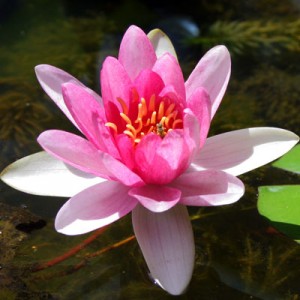
The Universal Principles of Alignment™ are an elegant and supremely effective system developed by Anusara® yoga’s founder, John Friend.
They have led to amazing innovation as far as what is possible on a yoga mat, as well as how you can more completely explore the inner realms.
The principles, like the philosophy with which they are so perfectly intertwined, have their roots deep in ancient wisdom, honoring the great teachers and systems of yoga which have come before.
They pulse between spaciousness and focus, so that each moment guides you to further refine and delight!
At their core is a constant commitment to the highest intentions of awakening and liberating the practitioner so you can live more joyfully in conscious connection to your truest, highest self.
And their branches, if you will, reach into the infinite possibilities that are constantly unfolding as more playful and profound creative expressions and experiences of life.
So what exactly are these principles, and how do you go about learning them?
Well, first of all, don’t worry about taking all of the information in this article in at once if you’re new to this yoga. Just feel your way through what makes sense to you, and notice what calls to your heart.
The Universal Principles of Alignment of Anusara Yoga
In order (and yes, the sequence is essential) they are:
- Opening to Grace and Setting the Foundation
- Muscular Energy
- Inner Spiral (Expanding Spiral)
- Outer Spiral (Contracting Spiral)
- Organic Energy
Which may or may not make any sense at all to you depending on if you’ve encountered them before. So let’s break it down in more understandable terms, shall we?
Opening to Grace
This is the first principle because it is most important. Everything else builds from it.
Before I give you any explanation of this, it is most helpful if you first consider what it means to you.
 What does it feel like to open to grace? Take a moment to ponder what comes to mind and heart. Take a minute – really, this self inquiry is important to learning what it’s about.
What does it feel like to open to grace? Take a moment to ponder what comes to mind and heart. Take a minute – really, this self inquiry is important to learning what it’s about.
Here are some ideas of Opening to Grace that have come up for me:
- Freedom
- Spaciousness
- Receptivity
- Illumination
- Feeling of connection with Source
- Happiness / Joy / Delight / Bliss
- Peace and deep content
I think you get the idea. Opening to Grace is tuning in to your inner being and the bigger energy that is everything in existence. And it isn’t difficult to do. Your breath is always there to help.
Try this mini-meditation to get a feel for this first and overarching principle:
Sit beautifully.
Settle into your hips.
Let your breath grow you taller.
Feel yourself be breathed.
Be spacious like a stainless sky.
Let your inner body be beautifully bright.
Soften your skin.
Notice the spacious feeling of being connected to something bigger than yourself that naturally comes when you bring your awareness to the moment and turn to your breath.
Another great way to invite this sensitivity is to open your ears: Listen, letting sounds come to you without grasping or judging, but simply witnessing.
So what does this mean when applied to your yoga practice?
Well, first off it means you’re not doing it alone. When you connect to a bigger energy you’re not only more in the flow of the pulsation of your practice, but you’ll find your capacity and ability is far more than if you were only working from your individual mindset.
Also, by being spacious and receptive you are more able to receive the gifts of your practice; physically, mentally, emotionally and spiritually. Insights can be more clear, and self transformation more harmonious.
Physically, opening to grace creates more space and naturally brings you toward a more optimal alignment. If you think “Inner Body Bright” what happens? Your breath helps you become more expansive and taller, the heart lifts, the throat opens, and tension melts away.
And what does it mean in life?
This spacious remembrance and honoring of the intrinsic goodness that is at the essence of you (and all that is) gives you a powerful tool. By being open to Spirit, you flow with the ease and grace that comes from knowing true wisdom. You make life enriching choices, always looking for the beauty and blessings that are offered, even in the most shrouded moments.
This tapping in to the true nature of oneness, of Spirit, is the most important thing. It is what makes all the difference.
Setting The Foundation
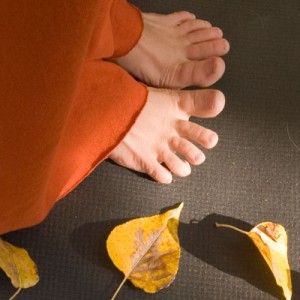 Like any structure, yoga is built from the foundation up.
Like any structure, yoga is built from the foundation up.
If you look at an asana, or yoga pose, the foundation of the pose which is touching the floor affects everything else.
If your foot is placed even slightly out of alignment, it translates up to your knee, pelvis, back, and so on. If your hand is turned out or the finger tips are lifted, your wrist, elbow, shoulder and neck may have a few words with you.
Part of this aspect of the first principle is setting your intention.
By having a clear focus, it makes the practice more meaningful and therefore you get a whole lot more out of it.
One of the ways we set intention and lay the vibrational foundation for practice is to sing the Anusara yoga Invocation. Such a beautiful mantra!
Your intention could really be anything from simply wanting to feel more alive and free to longing to connect with your highest self and purpose. You can even devote the energy of your practice to supporting an area of the world that needs extra love, or pour your heart into a grateful practice dedicated to your teacher. Anything’s game as long as it’s life enhancing, so get creative and let your heart suggest intentions for your practice. Notice how different your practice is when you make it more meaningful by using intention.
Having a beautifully aligned foundation is crucial not only physically, but also on every other level.
When you line up your feet with awareness, it reflects and impacts your commitment to your intention. It makes it a whole lot easier to move into a place where your desire to feel good (or realize any other intention) can happen.
Part of the foundation of yoga is your understanding of it, so it makes sense that everyone is at different levels.
For instance, if I walk into a beginning yoga class and see that many of the students’ feet are misaligned in warrior pose, it isn’t fair for me to think that none of them are committed to their intention of benefiting from yoga when they simply don’t know any better. But when I show them how to more skillfully align and they pay attention and apply that new knowledge, then THAT is a reflection that they are giving the practice their best effort, and that’s a beautiful thing.
Conversely, if I have a more intermediate class and I’ve reminded someone 9 times to keep their fingertips pressing into the mat in down dog, that person may need to make it more meaningful and commit to the integrity of their foundation.
A master checks their foundation every time because they understand how important it is.
If you keep checking in with your intention and the alignment of the part of your body that is on the floor, your practice will be so much more rewarding.
Setting the foundation is part of the first principle because it must be done precisely in order for the rest of the principles to be applied effectively, just like you have to lay the foundation of a house before putting up walls.
Another part of the foundation of yoga is the guiding ethics, known as the yamas and niyamas. Studying these powerful truths gives you access to a way to live life in the highest integrity, bringing great freedom and enrichment.
Muscular Energy
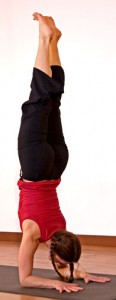 Also known as Muscle Energy, the second principle is all about integrating and creating a stability that allows for more freedom.
Also known as Muscle Energy, the second principle is all about integrating and creating a stability that allows for more freedom.
It is an embrace of the spacious bright opening and mindful placement of foundation and intention that are established in the first principle. And it is this that differentiates it from just a squeezing of the muscles – it’s a loving embrace; strong yet sensitive, not a stranglehold.
Muscular Energy brings a necessary strength and support.
I like how Virayoga explains it on their site:
it is a purposeful engagement of all parts of the outer body
towards their origin in the inner body to integrate
all parts of body and mind, creating stability and unity of intention.
It brings all parts together to participate as a whole being. This not only applies physically, but in every situation on every level.
In an interview I did with John Friend, he described using Muscular Energy in everyday life as a choice to focus and make the right effort and action to align with Spirit. It is the element that invites you to focus and pay attention.
Physically, Muscular Energy has three components. In sequence they are:
- Hug in concentrically – from skin to muscle, muscle to bone.
- Squeeze into the midline – the center line of the body
- Draw from periphery to core, so from feet and hands up through the core lines of the body into the Focal Point of the pose
If Muscular Energy is done before the expansive fullness of the first principle, the tendency is to over contract and block the flow of energy which stunts the expression of the pose.
Inner (Expanding) Spiral and Outer (Contracting) Spiral
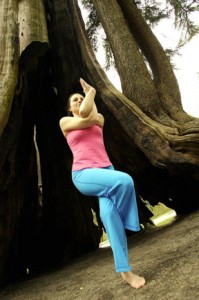 The third and fourth principles are powerful refinements that can be elusive to understand at first, but then empowering and liberating when you get them.
The third and fourth principles are powerful refinements that can be elusive to understand at first, but then empowering and liberating when you get them.
In the sense of applying the Spirals to life beyond the physical, they further demonstrate the pulsing, constantly changing and evolving nature of life. Here’s what John Friend has to say about them:
“The Spirals are about refining and becoming more sophisticated and more of a connoisseur of life off the mat. You hone your senses, hone your knowledge, hone the artistic expression of the knowledge, so you become more eloquent, and you become more artistic. Internally, the Spirals are the development and refinement of our desire to make creative beauty.” – John Friend
Physically the Spirals are instrumental in the alignment of the femurs, pelvis, and therefore the spine, and also come into play in the arms. I’ll explain only the actions of the legs here, as you really need to experience these in your practice to fully grasp them.
The action of Inner Spiral moves in, back, and apart, most notably aligning the femurs BACK and deeper into the hip sockets. Outer Spiral balances by moving in opposite directions, most easily recognized as a scoop of the tail bone.
The Spirals must be balanced in action and applied in sequence. You keep the thighs back while scooping the tail bone, which results in a more spacious pelvic floor, supported lower back, toned lower belly, and so on.
These principles are super fun to play with in your practice, opening up whole new worlds of creative expression and profound experience.
Organic Energy
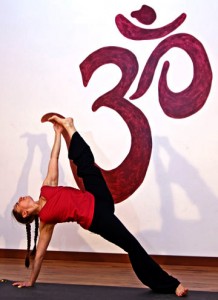 The fifth principle is all about shining out and fully participating in the grand play of yoga and life. This is where your creative expression really comes into fruition.
The fifth principle is all about shining out and fully participating in the grand play of yoga and life. This is where your creative expression really comes into fruition.
It’s an active reaching out to Grace in all the splendor of harmony and heart.
In every day life Organic Energy may be a radiant smile you offer (or receive) from someone who is very much in their center, or a wild dance of inspired and yet balanced ecstasy. It could be the push you need to get something really important done, all the while you stay strong in your center as you extend past your previous comfort zone.
And it could be an active and focused spaciousness which, in the inner realms of meditation, expands you into the next step of self-evolution.
Just as each step in the Universal Principles of Alignment build on those that come before, Organic Energy is like the culmination of the fullness that the structure of the principles creates.
Physically, you keep the integration of Muscular Energy, and then extend and stretch out from that place of feeling really plugged in. The brightness of the inner body expands out in every direction, and the full expression of the pose is honored.
Organic Energy happens in an opposite sequence compared to Muscular Energy:
- Lengthen from the focal point through the core lines of the body – first down through the foundation and then up and out the top of the pose
- Expand brightly out from the midline, widening and creating more space
- Broaden from the core out through the skin – you can think of this as energy expanding concentrically out from the bones through the muscles and glowing even past the skin.
Organic Energy must be done after the stabilization of Muscular Energy, otherwise there is a dis-intigration and de-stabilization. First you plug in to Source, then you shine out in your own individual expression of the One.
Putting it all Together
The principles pulsate. You open, then integrate. You widen and plug in. And you stretch out into the world in a way that glorifies the goodness of who you are and what your life is about.
Living the Universal Principles of Alignment in every aspect of life is one of the most skillful and supported ways you can engage life fully. Because it gives you a structure to dance within; a guide through the sticky places in life. And truly ANYTHING can be done as long as you follow these wise and empowering principles.
“… ultimately it’s for expansion and expression. Ultimately our life off the mat is a celebration of the Spirit that is moving through us, so that at the end of the day or at the end of a life you look back and think, ‘Wow! That was a great day. I gave it my full, I gave it my all. What a joy that was! What a blast – what a ride that was!’ So there’s no regret. Now I live my principles off the mat, full-on. Practice and ‘off the mat’ are not separate things. Realize it’s all one practice.” – John Friend
To further explore this amazing yoga, dive into the Anusara yoga Invocation Mantra and feel your heart soar!
This article was written with great gratitude to my teacher, John Friend, and the great teacher that is Anusara yoga.
- Please, if you have anything to add or express, leave a comment below!

hi Katrina
I enjoyed this post, as it really pulls together many, MANY of the teachings I have gotten through classes and workshops over the years. Great summary!!
I was imagining though, that this would be overwhelming for a beginner student… that is my only slightly negative comment.
I really like the pics you’ve included!
Tara,
Thanks for your comment. Yes, you’ve got a great point there – this could be a bit overwhelming for beginners if they were strictly trying to learn the Principles from this article.
The Principles of Alignment are meant to be learned in layers, not all in one go. This article is intended more as a reference for students of Anusara yoga, and a way to get a feel for what they mean off the mat. Truly, this could speak to people on many different levels, and it’s important not to get stuck in the terminology or technique if it’s confusing. Just getting a feel for each principle (or even one or two) is great!
Thanks for bringing that up!
Excellent description of Anusara’s Universal Principles of Alignment.
You have this incredible ability to explain the information to us on
whatever level we are at in this moment. You made it helpful,
motivating, and interesting. It also reminded me of how blessed I am
by the people in my life who practice this off the mat and in some cases
are not even aware of it. That is true grace.
Jerri,
One of my favorite things is recognizing people who are living by these principles without having been exposed to Anusara at all. To me it’s another example of how these principles are truly universal.
Thank so much you for your kind words, and for taking the time to read this offering.
Hey, Katrina. This is a great post – very informative and interesting. Though I have never taken an Anusara Yoga class, I’m continually intrigued and inspired when I read your posts and look forward to doing so.
Thanks John! So glad you’re enjoying these posts. There’s an excellent Anusara yoga teacher in Atlanta named Gina Minyard – you might check her out if you want to try this yoga. She’s super fun and a great person.
Blessings to you and your family!
Thanks for sharing this post. You made the upa much easier to understand. I am definetly a visual learner and seeing in writing what my incredible yoga teacher speaks about is a great gift to me.